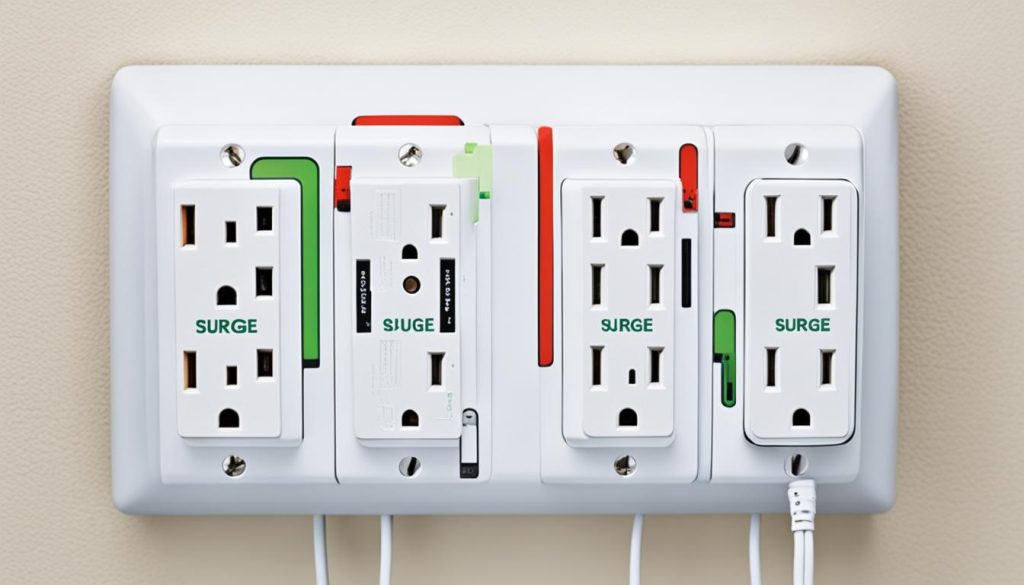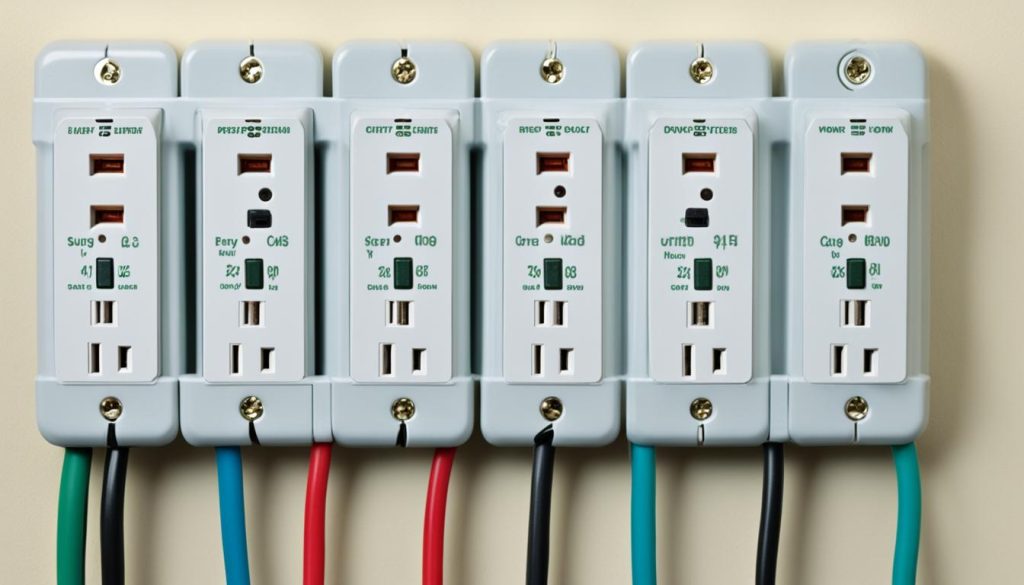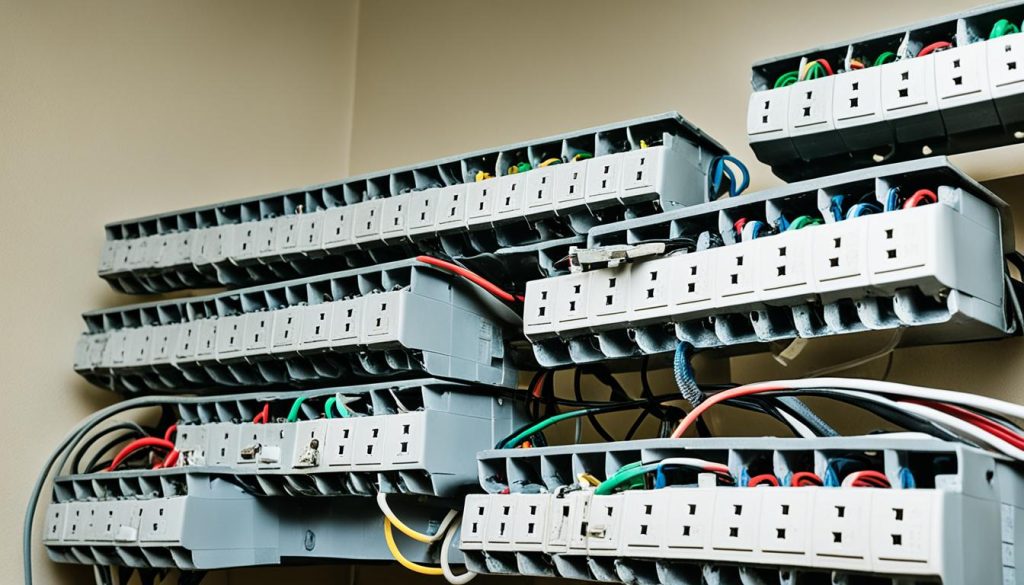Power strips and surge protectors may look similar, but they serve different functions. A power strip is a simple extension cord with multiple outlets, while a surge protector is designed to absorb and protect against power surges. Surge protectors have a rating in joules that indicates the maximum voltage they can handle. It’s important to use surge protectors for expensive electronics and appliances, while power strips are suitable for smaller devices.
Key Takeaways:
- To determine if your power strip is also a surge protector, check for a joules rating. Only surge protectors have this rating.
- Surge protectors provide added protection against power surges, which can damage expensive electronics.
- Power strips are suitable for smaller devices, while surge protectors are recommended for sensitive electronics and appliances.
- Using a surge protector can potentially save you money in the long run by preventing damage to your devices.
- Regularly check surge protectors for indicator lights or warnings to ensure they are still functioning properly.
Understanding Power Strip Function
A power strip is a versatile device that serves as an extension cord with multiple outlets, allowing you to conveniently connect and power multiple electronic devices from a single power source. Whether you have a shortage of electrical sockets in your home or need a neat and organized solution for your workspace, a power strip offers the flexibility you need.
Power strips come in various configurations, offering anywhere from two to a dozen outlets. This allows you to connect devices such as laptops, smartphones, printers, lamps, and more in one centralized location. Additionally, power strips may also have USB ports for charging your devices directly without the need for bulky adapters or chargers.
| Features of Power Strips: | Benefits: |
|---|---|
| Multiple outlets | Provides access to numerous electrical sockets |
| Extension cord | Enables flexibility in device placement |
| USB ports | Allows for convenient charging of devices |
| Mounting brackets | Facilitates easy installation and organization |
While power strips offer convenience, it’s crucial to prioritize safety. Avoid overloading the power strip by plugging in devices that exceed its capacity, as this can lead to overheating and potential fire hazards. Be sure to use power strips with built-in safety features, such as surge protection and circuit breakers, to protect your devices and prevent electrical accidents.
Mounting brackets are also a beneficial feature of some power strips, allowing you to securely attach them to walls, desks, or other surfaces, keeping cables organized and reducing clutter.
By understanding how power strips function and employing them safely, you can enhance the efficiency and convenience of your electronic setups while ensuring a tidy workspace or living area.
Understanding Surge Protector Function
A surge protector is an essential device that provides additional protection against power surges, safeguarding your valuable electronics from potential damage. While it may resemble a power strip, a surge protector offers advanced features and capabilities to ensure the longevity and reliability of your devices.
When a power surge occurs, an excessive amount of voltage can flow into your electronic equipment, exceeding their safe operating levels. This sudden surge can result from lightning strikes, utility grid fluctuations, or even internal faults within your home’s electrical system.
An effective surge protector functions by absorbing and redirecting excess voltage away from your connected devices, preventing potential damage. It acts as a protective barrier, absorbing the surge and ensuring that only safe levels of electricity reach your electronics.
Surge protectors are designed with a joules rating, which represents their ability to handle power spikes. A higher joules rating indicates a greater capability to handle larger surges. It is essential to choose a surge protector with a sufficient joules rating to adequately protect your valuable electronics.
Aside from protecting against voltage spikes, surge protectors also offer additional outlets to accommodate multiple devices simultaneously. These outlets allow you to conveniently connect and power your electronics, providing a clutter-free and organized setup.
In addition to surge protection and extra outlets, durability is a crucial factor to consider when selecting a surge protector. A well-built and reliable surge protector ensures a prolonged lifespan, offering long-term protection for your electronics.
Surge Protector Features:
- Advanced surge protection
- Multiple outlets for convenient connectivity
- Durable construction for long-lasting performance
By investing in a surge protector, you can enjoy peace of mind knowing that your valuable electronics are protected against power surges, ensuring their optimal performance and longevity.

| Advantages of Surge Protectors | Detailed Explanation |
|---|---|
| Protection against power surges | Surge protectors absorb excess voltage and redirect it away from connected devices, preventing potential damage. |
| Additional outlets | Surge protectors offer numerous outlets, allowing you to connect multiple devices simultaneously. |
| Durability | High-quality surge protectors are built to last, providing long-term protection for your electronics. |
How to Differentiate Between a Power Strip and a Surge Protector
Differentiating between a power strip and a surge protector can be challenging since they look similar. However, there are some key indicators to look for.
- Surge Protector Markings: Surge protectors will have specific markings displayed on the packaging or the device itself, indicating their surge protection capabilities. Look for labels such as “surge protector,” “surge suppressor,” or “surge protection.”
- Surge Protector Joules Rating: One of the essential features of a surge protector is its joules rating. This rating indicates the amount of energy the surge protector can absorb and handle during a power surge. Higher joules ratings indicate better protection. Look for the joules rating displayed on the packaging or the surge protector itself.
- Additional Outlets: Surge protectors may have additional outlets specifically designed for phone lines, ethernet cables, coaxial cables, or even USB ports. These additional outlets are not typically found on power strips.
By checking for these features – surge protector markings, joules rating, and additional outlets – you can easily differentiate between a power strip and a surge protector, ensuring that your valuable electronic devices are protected from power surges and potential damage.

Factors to Consider When Choosing Between a Power Strip and a Surge Protector
When deciding between a power strip and a surge protector, there are a few important factors to take into account: cost, durability, and reliability. Let’s explore each of these considerations in detail to help you make an informed decision.
Power Strip Cost
One of the primary factors to consider is the cost. Power strips are generally more affordable compared to surge protectors. They provide a convenient solution for expanding the number of outlets available for smaller devices without breaking the bank.
Surge Protector Cost
On the other hand, surge protectors may cost slightly more than power strips. However, it’s important to remember that surge protectors offer added protection against power surges, which can save you money in the long run. By investing in a surge protector, you can safeguard your expensive electronics from potentially costly damage caused by voltage spikes.
Power Strip Durability
When it comes to durability, power strips are generally built to withstand regular use. However, they may not be as robust as surge protectors when it comes to handling sudden voltage increases. If you primarily use power strips for small electronics or non-sensitive devices, their durability should be sufficient for your needs.
Surge Protector Reliability
Surge protectors, on the other hand, are specifically designed to reliably protect your devices from power surges. They have built-in features and technologies that absorb and redirect excess voltage, ensuring that your valuable electronics remain safe. Surge protectors often come with a higher level of reliability compared to power strips when it comes to protecting against electrical fluctuations and surges.
It’s important to note that both power strips and surge protectors have a lifespan. If they become damaged or worn out, it’s crucial to replace them to ensure continued protection for your devices.
Summary
To summarize, when choosing between a power strip and a surge protector, it’s essential to consider the cost, durability, and reliability of both options. While power strips are more affordable and suitable for smaller devices, surge protectors offer added protection against power surges and potential savings by preventing damage to expensive electronics. Assess your specific needs and budget to make the best decision for protecting your electronic devices.

| Factors | Power Strip | Surge Protector |
|---|---|---|
| Cost | Affordable | Slightly more expensive |
| Durability | Sufficient for small devices | Specifically designed for protection |
| Reliability | Standard protection | Reliable protection against power surges |
Proper Use of Power Strips and Surge Protectors
Ensuring the proper use of power strips and surge protectors is crucial for maintaining safety and maximizing their effectiveness. By following a few simple guidelines, you can protect your devices and prevent potential hazards.
Power Strip Safety Guidelines
When using power strips, it’s important to avoid overloading them. Overloading a power strip can lead to overheating and pose a fire risk. Make sure to check the power strip’s amp rating and never exceed the recommended limit. High-power consuming devices such as space heaters or air conditioners should be plugged directly into a wall outlet to prevent overheating of the power strip.
Here are some power strip safety guidelines to keep in mind:
- Regularly inspect power strips for any signs of damage, such as frayed cords or loose outlets. Replace damaged power strips immediately.
- Avoid enclosing power strips in tightly enclosed spaces, as it can lead to overheating. Keep them in well-ventilated areas.
- Do not use power strips near water sources or in wet conditions to minimize the risk of electrical shock.
- Use power strips only for smaller devices and avoid plugging in high-power consuming appliances like refrigerators or washing machines.
Surge Protector Maintenance
Surge protectors play a crucial role in safeguarding your sensitive electronics from power surges. To ensure their effectiveness, it’s essential to maintain and inspect surge protectors regularly.
Here are a few maintenance tips for surge protectors:
- Check surge protectors for indicator lights that signal if they are still functioning properly. If the indicator light is off or not functioning, consider replacing the surge protector.
- Inspect surge protectors for any visible damage or wear. Damaged surge protectors may not provide adequate protection and should be replaced.
- Ensure surge protectors are plugged directly into a wall outlet and not daisy-chained to other power strips or surge protectors.
- Keep surge protectors in an easily accessible location to facilitate regular maintenance and inspection.
Surge Protector Indicator Lights
Surge protectors often come equipped with indicator lights that provide valuable information about their status. These lights can indicate if the surge protector is still functioning properly or if it needs to be replaced.
Here are some common indicator light statuses and their meanings:
| Indicator Light Color | Status | Meaning |
|---|---|---|
| Green | On | The surge protector is functioning properly and protecting your devices. |
| Red | Off | The surge protector has reached its maximum limit or is no longer providing protection. Consider replacing it. |
| Yellow | Flashing | The surge protector is providing limited protection and may need to be replaced. |
Regularly checking the indicator lights of your surge protector ensures that it is still providing optimal protection for your devices.
When to Replace Surge Protectors
Surge protectors are essential for safeguarding your electronic devices from power surges and voltage spikes. Over time, surge protectors can wear out, especially after experiencing a significant power surge or a lightning strike. It’s important to know when to replace your surge protector to ensure continued protection for your valuable devices.
- After a Power Surge: If your surge protector has been exposed to a power surge, it may have absorbed a significant amount of excess voltage. It’s recommended to replace the surge protector after such an event to ensure its effectiveness in future surges.
- Indicator Lights or Warnings: Some surge protectors come with indicator lights that signal when they need to be replaced. These lights may indicate a variety of conditions, including a worn-out surge protector or decreased protection levels. If your surge protector has such indicators, it’s important to pay attention to them and replace the device accordingly.
- Lifespan: Surge protectors have a limited lifespan, typically ranging from 3 to 5 years. It’s advisable to replace your surge protector within this timeframe to maintain optimal protection for your devices. However, if your surge protector has been subjected to frequent power surges or extreme voltage spikes, it may need replacement sooner.
- Check the Warranty: When purchasing a surge protector, it’s important to check the warranty provided by the manufacturer. Some surge protectors come with a warranty that covers damage to connected devices in case of a power surge. If your surge protector is still within the warranty period and experiencing issues, you may be eligible for a replacement.
By replacing your surge protector in a timely manner, you can ensure the continued safety and protection of your valuable electronics.

Surge Protector Replacement Guidelines
| Replacement Criteria | Recommendation |
|---|---|
| After a significant power surge or lightning strike | Replace immediately |
| Indicator lights or warnings indicate replacement | Replace as indicated |
| Lifespan of surge protector | Replace within 3-5 years |
| Warranty coverage | Check warranty and replace if eligible |
The Importance of Surge Protectors for Electronics
Surge protectors are a crucial investment when it comes to safeguarding your valuable electronics from voltage spikes and power surges. In an instant, power surges can wreak havoc on your computers, laptops, TVs, and other sensitive devices, potentially causing irreversible damage. Fortunately, by utilizing surge protectors, you can provide an additional layer of protection for your electronic devices, helping you avoid costly repairs or replacements down the line.
Investing in surge protectors is a proactive measure that can significantly extend the longevity of your electronics. These devices are designed to absorb and redirect excessive voltage, ensuring that your devices receive only the required amount of power. With surge protectors in place, you can rest easy knowing that your electronics are shielded from the unpredictable nature of power surges.
Not only do surge protectors offer protection, but they also provide several other benefits. They help to prolong the lifespan of your electronics by preventing wear and tear caused by sudden voltage fluctuations. Additionally, surge protectors can help you avoid the inconvenience of unexpected device failures, allowing you to continue using your electronics without interruptions.
By investing in surge protectors for your electronics, you are making a wise decision that can save you both time and money. Protecting your devices from potential damage not only ensures their longevity but also provides you with peace of mind. Don’t wait for a power surge to leave you with damaged electronics—take proactive action and prioritize the safety of your valuable devices with surge protectors.
FAQ
How can I tell if my power strip is also a surge protector?
Surge protectors will have a joules rating displayed on the packaging or the device itself. Additionally, surge protectors may have additional outlets for phone, modem, or coaxial cables.
What is the function of a power strip?
Power strips are essentially extension cords with multiple outlets, providing convenient access to multiple electrical sockets from a single power source.
What is the function of a surge protector?
Surge protectors absorb and redirect excess voltage to prevent damage to connected devices, providing additional protection against power surges.
How can I differentiate between a power strip and a surge protector?
Surge protectors will have a joules rating displayed on the packaging or the device itself. Additionally, they may have outlets for phone, modem, or coaxial cables.
What factors should I consider when choosing between a power strip and a surge protector?
Factors to consider include cost, with power strips generally being more affordable, and surge protectors providing added protection and potentially saving money in the long run.
How should I properly use power strips and surge protectors?
Power strips should not be overloaded, and high-power consumption devices should not be plugged into them. Surge protectors should be used for sensitive electronics and appliances.
When should surge protectors be replaced?
Surge protectors should be replaced after a significant power spike or lightning strike, and it’s important to check the warranty for any protection offered for connected devices.
Why are surge protectors important for electronics?
Surge protectors provide an additional layer of protection for valuable electronics, potentially saving from costly repairs or replacements and ensuring their longevity.


